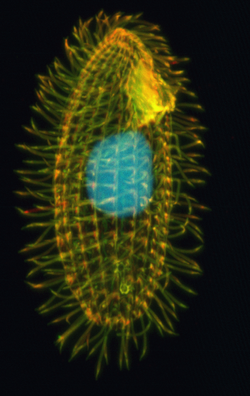Tetrahymena thermophila
| Tetrahymena thermophila | |
|---|---|
 Tetrahymena thermophila | |
| Videnskabelig klassifikation | |
| Domæne | Eukaryoter |
| (urangeret) | SAR |
| (urangeret) | Alveolata |
| Række | Ciliater |
| Klasse | Oligohymenophorea |
| Orden | Hymenostomatida |
| Familie | Tetrahymenidae |
| Slægt | Tetrahymena |
| Art | T. thermophila |
| Videnskabeligt artsnavn | |
| Tetrahymena thermophila | |
| Hjælp til læsning af taksobokse | |
Tetrahymena thermophila er frit-levende mikrober som er en ciliat protozo, som også kan skifte mellem levemåderne kommensal og patogen. Tetrahymena thermophila er almindelig i ferskvandsdamme og er 30-60 mikrometer stor.
En modelorganisme i eksperimentalbiologi

Som en ciliat protozo udviser Tetrahymena thermophila kernedimorfisme: To typer af cellekerner. Tetrahymena thermophila har samtidigt en større somatisk makrokerne og en mindre kimbane mikrokerne (til sex) i hver celle og kernerne udfører forskellige funktioner med distinkte cytologiske og biologiske egenskaber. Denne unikke alsidighed tillader videnskabsfolk til at anvende Tetrahymena thermophila til at identificere adskillige vigtige faktorer vedrørende genekspression og genomintegritet. Herudover har Tetrahymena thermophila hundreder af cilier og har komplicerede mikrotubulistrukturer, hvilken gør Tetrahymena thermophila til den optimale model til at illustrere diversitet og mikrotubulisystems funktioner.
Tetrahymena thermophila eksisterer i syv forskellige køn, som kan reproducere i 21 forskellige kombinationer - og en enkelt Tetrahymena thermophila kan ikke reproducere sig seksuelt med sig selv. Hvert individ "beslutter" hvilket køn den vil blive under parring via en stokastisk proces.[1][2][3]
Kilder/referencer
- ^ Selecting; Segment Joining, Gene; Deletion; Cervantes, MD; Hamilton, EP; Xiong, J; Lawson, MJ; Yuan, D; et al. (2013). "Selecting One of Several Mating Types through Gene Segment Joining and Deletion in Tetrahymena thermophila". PLoS Biol. 11 (3): e1001518. doi:10.1371/journal.pbio.1001518.
- ^ 27 March 2013, nature.com: How a microbe chooses among seven sexes Citat: "...Biologists have uncovered the genetic mechanisms by which an unusual microbe assumes one of seven possible sexes...It was known that “the mating type of the parents has no influence on what the mating type of the progeny is going to be,”..."
- ^ 2 March 2011, newscientist.com: Zoologger: The hairy beast with seven fuzzy sexes Citat: ".... It has not two but seven sexes, and each one can mate with any of the others...As if that weren’t enough, sex itself is different for this animal. Most cells have a single nucleus that contains all their DNA, but Tetrahymena has two: a large macronucleus and a small micronucleus. The macronucleus controls the everyday functions of the cell, while the micronucleus deals with its complicated sex life..."
Yderligere læsning
- Methods in Cell Biology Volume 62: Tetrahymena thermophila, Edited by David J. Asai and James D. Forney. (2000). By Academic Press ISBN 0-12-544164-9
- Collins, K.; Gorovsky, M.A. (2005). "Tetrahymena thermophila 5004392". Curr Biol. 15: R317-8. doi:10.1016/j.cub.2005.04.039. (Webside ikke længere tilgængelig)
- Eisen, JA; Coyne, RS; Wu, M; Wu, D; Thiagarajan, M; et al. (2006). "Macronuclear Genome Sequence of the Ciliate Tetrahymena thermophila, a Model Eukaryote". PLoS Biol. 4 (9): e286. doi:10.1371/journal.pbio.0040286. PMC 1557398. PMID 16933976.
Eksterne henvisninger
| Wikimedia Commons har medier relateret til: |
- Tetrahymena Stock Center at Cornell University
- ASSET: Advancing Secondary Science Education thru Tetrahymena
- Tetrahymena Genome Database
- Biogeography and Biodiversity of Tetrahymena
- Tetrahymena thermophila Genome Project Arkiveret 15. januar 2008 hos Wayback Machine at The Institute for Genomic Research
Medier brugt på denne side
Forfatter/Opretter: see source, Licens: CC BY 2.5
The genome sequence of the single-celled ciliate Tetrahymena thermophila sheds light on early eukaryotic evolution.
Forfatter/Opretter: Pawel Jasnos, Licens: CC BY-SA 3.0
Beta-Tubulin in Tetrahymena cell, visualised using GFP-marked anti-beta tubulin antibodies under confocal microscopy. Work supervised by Dr Hanna Fabczak. Made during Polish Children Fund's workshops at M. Nencki Institute of Experimental Biology in Warsaw


